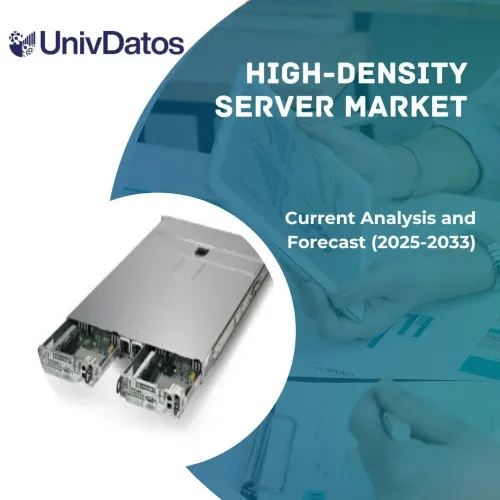- Strona główna
- O nas
- Branża
- Usługi
- Czytanie
- Kontakt
Rynek telekomunikacyjny MENA: bieżąca analiza i prognoza (2023-2030)
Nacisk na typ (mobilny, linia stacjonarna i szerokopasmowy) oraz technologię (4G/LTE, 5G, światłowody i inne); kraj
Geografia:
Przemysł:
Ostatnia aktualizacja:
Apr 2024
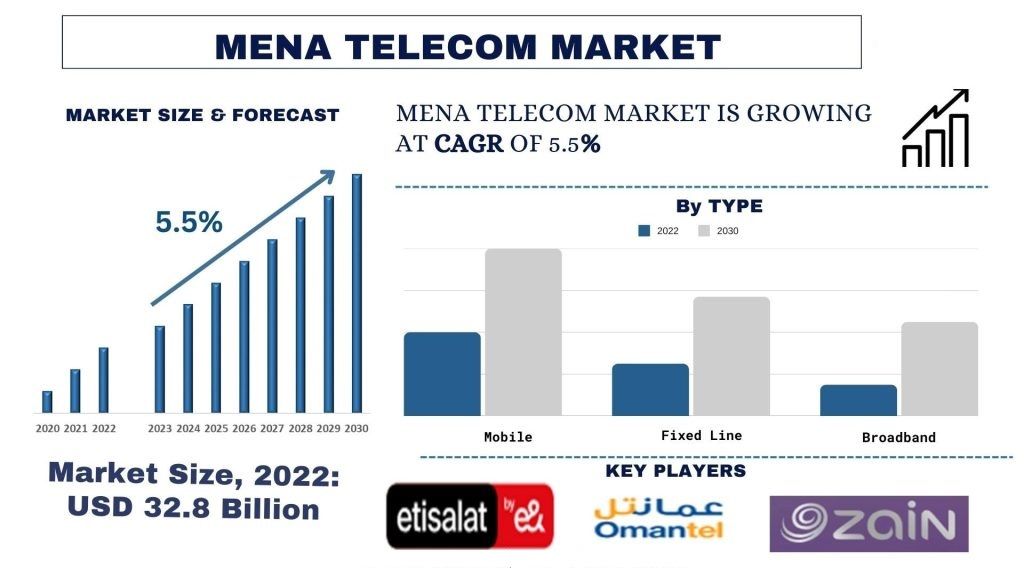
Wartość rynku telekomunikacyjnego MENA w 2022 roku wyniosła 32,8 miliarda dolarów i oczekuje się, że będzie rosła w stałym tempie około 5,5% w prognozowanym okresie (2023-2030).
Region Bliskiego Wschodu i Afryki Północnej (MENA) jest świadkiem rewolucji w telekomunikacji, napędzanej przez szybki postęp technologiczny, zmieniające się wymagania konsumentów i ambitne inicjatywy rządowe. Jako jeden z najbardziej dynamicznych i konkurencyjnych rynków na świecie, sektor telekomunikacyjny MENA stwarza niezliczone możliwości i wyzwania dla graczy branżowych, którzy chcą wykorzystać jego potencjał. Patrząc w przyszłość, rynek telekomunikacyjny MENA jest gotowy na dalszy wzrost i innowacje, napędzane przez postęp w technologii cyfrowej, zmieniające się zachowania konsumentów i inicjatywy rządowe. Kluczowe obszary zainteresowania obejmują wdrażanie sieci 3G, rozprzestrzenianie się aplikacji IoT, rozwój usług cyfrowych oraz przyjęcie nowych technologii, takich jak sztuczna inteligencja i blockchain. Ponadto partnerstwa i współpraca między sektorami będą miały kluczowe znaczenie dla odblokowania nowych możliwości i zaspokojenia zmieniających się potrzeb klientów.
Niektórzy z głównych graczy działających na rynku to BATELCO, Emirates Integrated Telecommunications Company (du), Etisalat, Oman Telecommunications Company, Ooredoo, Orange, Saudi Telecom Company (stc), Telecom Egypt, VEON LTD i ZAIN.
Wgląd przedstawiony w raporcie
„Wśród typów, segment mobilny odnotował znaczny wzrost w 2022 r.”
Na podstawie typu rynek jest podzielony na mobilny, linię stacjonarną i szerokopasmowy. Warto zauważyć, że segment mobilny objął prowadzenie w 2022 r., wskazując na rosnące uzależnienie regionu od komunikacji komórkowej w celu zapewnienia łączności. Na przykład, wraz ze wzrostem popularności smartfonów i korzystania z mobilnego internetu, dostawcy usług telekomunikacyjnych koncentrują się na rozbudowie swoich sieci komórkowych i oferowaniu konkurencyjnych planów taryfowych, aby sprostać rosnącemu zapotrzebowaniu na usługi mobilne.
„Wśród technologii, segment 4G odnotował znaczny wzrost na rynku.”
Na podstawie technologii rynek jest podzielony na 2G, 3G, 4G i 5G. Segment 4G wyłonił się jako lider rynku w 2022 r., sygnalizując powszechne przyjęcie szybkiego mobilnego internetu i usług transmisji danych. Na przykład operatorzy telekomunikacyjni inwestują w modernizację swoich sieci do technologii 4G LTE (Long-Term Evolution), aby zapewnić szybsze prędkości internetu i lepszą wydajność sieci, zaspokajając potrzeby zarówno konsumentów, jak i przedsiębiorstw.
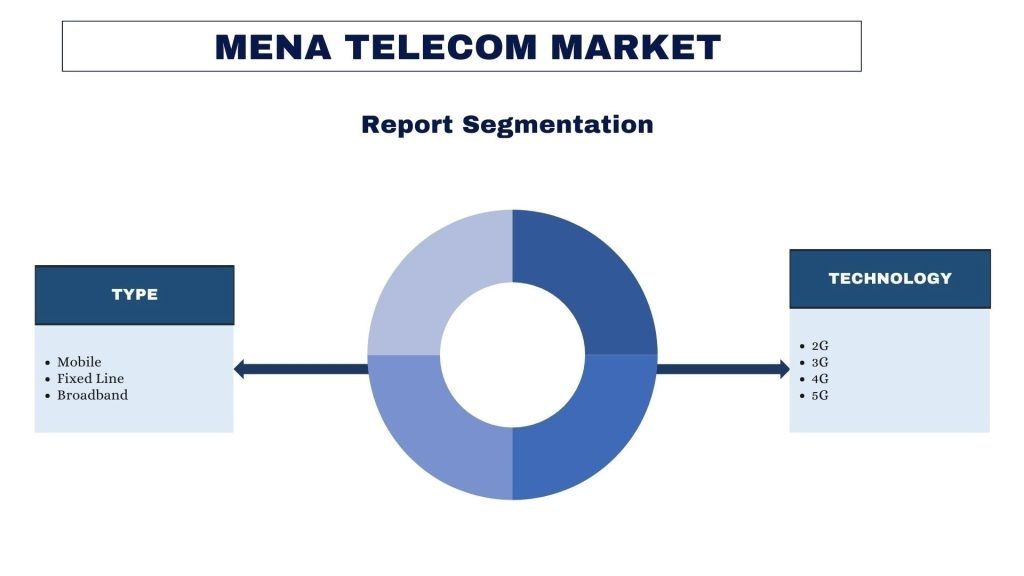
„Arabia Saudyjska ma znaczny udział w rynku telekomunikacyjnym MENA w 2022 r.”
Rynek telekomunikacyjny w Arabii Saudyjskiej szybko rośnie i ulega dywersyfikacji. Główni międzynarodowi dostawcy usług telekomunikacyjnych, w tym firmy takie jak BATELCO, Ooredoo i Zain, ustanowili swoją obecność w Arabii Saudyjskiej, aby wykorzystać rosnący rynek. Ponadto lokalne firmy, takie jak Saudi Telecom Company (STC) i Mobily, również inwestują w rozbudowę swoich możliwości telekomunikacyjnych. Arabia Saudyjska jest dobrze usytuowana geograficznie jako brama między Europą, Azją i Afryką, co czyni ją idealną lokalizacją do pełnienia roli regionalnego centrum danych. Stabilne środowisko polityczne i solidna infrastruktura kraju również przyczyniają się do jego atrakcyjności dla inwestycji telekomunikacyjnych.
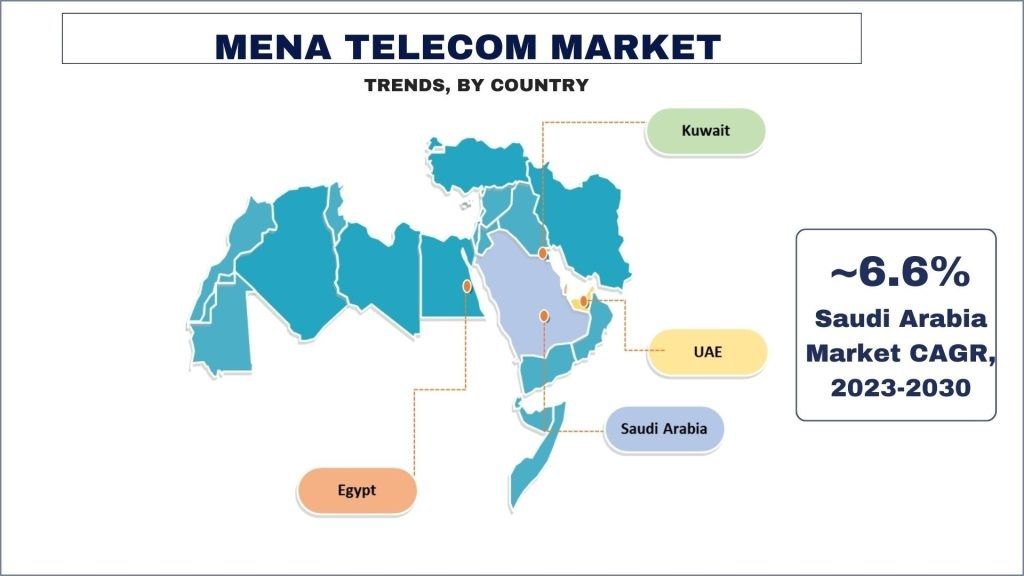
Zakres raportu o rynku telekomunikacyjnym MENA
Atrybut raportu | Szczegóły |
Rok bazowy | 2022 |
Okres prognozy | 2022-2030 |
Dynamika wzrostu | Przyspieszenie ze średniorocznym tempem wzrostu 5,5% |
Wielkość rynku 2022 | 32,8 miliarda USD |
Analiza regionalna | MENA |
Główny kraj wnoszący wkład | Arabia Saudyjska ma znaczący udział w rynku |
Kluczowe kraje objęte | ZEA, Arabia Saudyjska, Iran, Egipt, reszta MENA |
Profile firm | BATELCO, Emirates Integrated Telecommunications Company (du), Etisalat, Oman Telecommunications Company, Ooredoo, Orange, Saudi Telecom Company (stc), Telecom Egypt, VEON LTD i ZAIN. |
Zakres raportu | Trendy rynkowe, czynniki napędowe i ograniczenia; szacowanie i prognoza przychodów; analiza segmentacji; wpływ COVID-19; analiza popytu i podaży; krajobraz konkurencyjny; profilowanie firm |
Segmenty objęte | Typ i technologia |
Powody, dla których warto kupić ten raport:
- Badanie obejmuje analizę wielkości i prognozowania rynku, zweryfikowaną przez uwierzytelnionych kluczowych ekspertów branżowych.
- Raport przedstawia szybki przegląd ogólnej wydajności branży na pierwszy rzut oka.
- Raport zawiera dogłębną analizę wybitnych podmiotów z branży, koncentrując się przede wszystkim na kluczowych finansach biznesowych, portfelach produktów, strategiach ekspansji i ostatnich wydarzeniach.
- Szczegółowe badanie czynników napędowych, ograniczeń, kluczowych trendów i możliwości panujących w branży.
- Badanie kompleksowo obejmuje rynek w różnych segmentach.
- Dogłębna analiza regionalna branży.
Opcje dostosowywania:
Rynek telekomunikacyjny MENA można dodatkowo dostosować do wymagań lub jakiegokolwiek innego segmentu rynku. Poza tym UMI rozumie, że możesz mieć własne potrzeby biznesowe, dlatego zapraszamy do kontaktu z nami, aby uzyskać raport, który w pełni odpowiada Twoim wymaganiom.
Spis treści
Metodologia badań dla analizy rynku telekomunikacyjnego MENA
(2023-2030)
Analiza historycznego rynku, oszacowanie bieżącego rynku i prognozowanie przyszłego rynku telekomunikacyjnego MENA to trzy główne kroki podjęte w celu stworzenia i analizy adopcji telekomunikacji w regionie MENA. Przeprowadzono wyczerpujące badania wtórne w celu zebrania historycznych danych rynkowych i oszacowania obecnej wielkości rynku. Po drugie, aby zweryfikować te spostrzeżenia, wzięto pod uwagę liczne ustalenia i założenia. Ponadto przeprowadzono wyczerpujące wywiady pierwotne z ekspertami branżowymi w całym łańcuchu wartości rynku telekomunikacyjnego MENA. Po założeniu i walidacji danych rynkowych za pośrednictwem wywiadów pierwotnych, zastosowaliśmy podejście top-down/bottom-up do prognozowania całkowitej wielkości rynku. Następnie zastosowano metody podziału rynku i triangulacji danych w celu oszacowania i analizy wielkości rynku segmentów i podsegmentów branży. Szczegółowa metodologia została wyjaśniona poniżej:
Analiza historycznej wielkości rynku
Krok 1: Dogłębne badanie źródeł wtórnych:
Szczegółowe badania wtórne przeprowadzono w celu uzyskania historycznej wielkości rynku telekomunikacyjnego MENA ze źródeł wewnętrznych firmy, takich jakraporty roczne i sprawozdania finansowe, prezentacje wyników, komunikaty prasowe itp.oraz źródeł zewnętrznych, w tymczasopisma, wiadomości i artykuły, publikacje rządowe, publikacje konkurencji, raporty sektorowe, bazy danych stron trzecich i inne wiarygodne publikacje.
Krok 2: Segmentacja rynku:
Po uzyskaniu historycznej wielkości rynku telekomunikacyjnego MENA, przeprowadziliśmy szczegółową analizę wtórną w celu zebrania historycznych spostrzeżeń rynkowych i udziałów dla różnych segmentów i podsegmentów dla głównych regionów. Główne segmenty ujęte w raporcie to Typ i Technologia. Następnie przeprowadzono analizy na poziomie krajowym w celu oceny ogólnego przyjęcia modeli testowania w danym regionie.
Krok 3: Analiza czynnikowa:
Po uzyskaniu historycznej wielkości rynku różnych segmentów i podsegmentów, przeprowadziliśmy szczegółowąanalizę czynnikowąw celu oszacowania obecnej wielkości rynku telekomunikacyjnego MENA. Ponadto przeprowadziliśmy analizę czynnikową z wykorzystaniem zmiennych zależnych i niezależnych, takich jak rosnące zapotrzebowanie na energię odnawialną. Przeprowadzono dogłębną analizę scenariuszy popytu i podaży, biorąc pod uwagę najważniejsze partnerstwa, fuzje i przejęcia, ekspansję biznesową i wprowadzenia produktów na rynku telekomunikacyjnym MENA.
Szacowanie i prognoza obecnej wielkości rynku
Określanie obecnej wielkości rynku:W oparciu o praktyczne wnioski z powyższych 3 kroków, doszliśmy do obecnej wielkości rynku, kluczowych graczy na rynku telekomunikacyjnym MENA i udziałów rynkowych segmentów. Wszystkie wymagane podziały udziałów procentowych i podziały rynku zostały określone przy użyciu wspomnianego powyżej podejścia wtórnego i zostały zweryfikowane poprzez wywiady pierwotne.
Oszacowanie i prognozowanie:W celu oszacowania i prognozy rynku, wagę przypisano różnym czynnikom, w tym czynnikom napędzającym i trendom, ograniczeniom i możliwościom dostępnym dla interesariuszy. Po przeanalizowaniu tych czynników zastosowano odpowiednie techniki prognozowania, tj. podejście top-down/bottom-up, w celu opracowania prognozy rynkowej na rok 2028 dla różnych segmentów i podsegmentów na głównych rynkach MENA. Metodologia badawcza przyjęta do oszacowania wielkości rynku obejmuje:
- Wielkość rynku branży, pod względem przychodów (USD) i wskaźnik adopcji rynku telekomunikacyjnego MENA na głównych rynkach krajowych.
- Wszystkie udziały procentowe, podziały i podziały segmentów i podsegmentów rynku
- Kluczowi gracze na rynku telekomunikacyjnym MENA pod względem oferowanych produktów. Ponadto strategie wzrostu przyjęte przez tych graczy, aby konkurować na szybko rozwijającym się rynku.
Walidacja wielkości i udziału w rynku
Badania pierwotne:Przeprowadzono dogłębne wywiady z kluczowymi liderami opinii (KOL), w tym z kierownictwem wyższego szczebla (CXO/VP, szefowie sprzedaży, szefowie marketingu, szefowie operacyjni, szefowie regionalni, szefowie krajowi itp.) w głównych regionach. Wyniki badań pierwotnych zostały następnie podsumowane, a analiza statystyczna została przeprowadzona w celu udowodnienia postawionej hipotezy. Dane z badań pierwotnych zostały skonsolidowane z ustaleniami wtórnymi, przekształcając tym samym informacje w praktyczne wnioski.
Kluczowi interesariusze rynku telekomunikacyjnego w regionie MENA
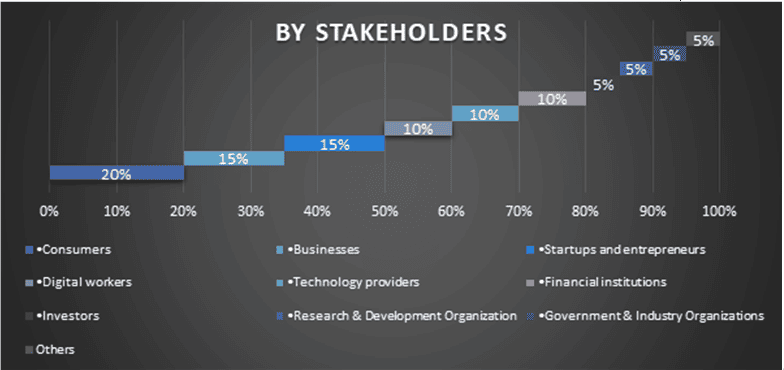
Inżynieria rynku
Technika triangulacji danych została zastosowana w celu uzupełnienia ogólnego oszacowania rynku i uzyskania precyzyjnych danych statystycznych dla każdego segmentu i podsegmentu rynku telekomunikacyjnego MENA. Dane podzielono na kilka segmentów i podsegmentów po przestudiowaniu różnych parametrów i trendów w obszarach typu pojazdu i technologii na rynku telekomunikacyjnym MENA.
Główny cel badania rynku telekomunikacyjnego MENA
Bieżące i przyszłe trendy rynkowe rynku telekomunikacyjnego MENA zostały wskazane w badaniu. Inwestorzy mogą uzyskać strategiczne spostrzeżenia, aby oprzeć swoje decyzje inwestycyjne na analizie jakościowej i ilościowej przeprowadzonej w badaniu. Bieżące i przyszłe trendy rynkowe determinowały ogólną atrakcyjność rynku na poziomie regionalnym, zapewniając platformę dla uczestnika branżowego, aby wykorzystać niewykorzystany rynek i czerpać korzyści z przewagi pierwszego gracza. Inne cele ilościowe badań obejmują:
- Analiza obecnej i prognozowanej wielkości rynku telekomunikacyjnego MENA pod względem wartości (USD). Ponadto analiza obecnej i prognozowanej wielkości rynku różnych segmentów i podsegmentów.
- Segmenty w badaniu obejmują obszary takie jak typ i technologia.
- Zdefiniowanie i analiza ram regulacyjnych dla telekomunikacji MENA
- Analiza łańcucha wartości związanego z obecnością różnych pośredników, wraz z analizą zachowań klientów i konkurencji w branży.
- Analiza obecnej i prognozowanej wielkości rynku telekomunikacyjnego MENA dla głównego regionu.
- Profile firm na rynku telekomunikacyjnym MENA i strategie wzrostu przyjęte przez graczy rynkowych w celu utrzymania się na szybko rozwijającym się rynku.
- Dogłębna analiza regionalna branży.
Najczęściej zadawane pytania FAQ
P1: Jaki jest aktualny rozmiar rynku i potencjał wzrostu rynku telekomunikacyjnego MENA?
P2: Jakie są czynniki napędzające wzrost rynku telekomunikacyjnego MENA?
P3: Który segment ma największy udział w rynku telekomunikacyjnym MENA według typu?
P4: Który kraj odnotuje znaczny wzrost na rynku telekomunikacyjnym MENA?
P5: Kim są kluczowi gracze działający na rynku telekomunikacyjnym MENA?
Powiązane Raporty
Klienci, którzy kupili ten przedmiot, kupili również







